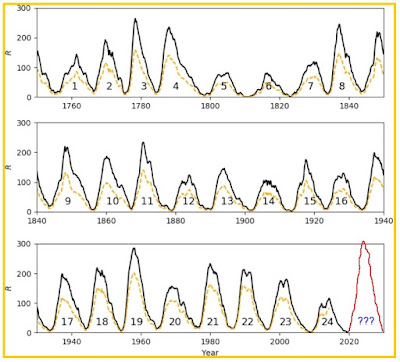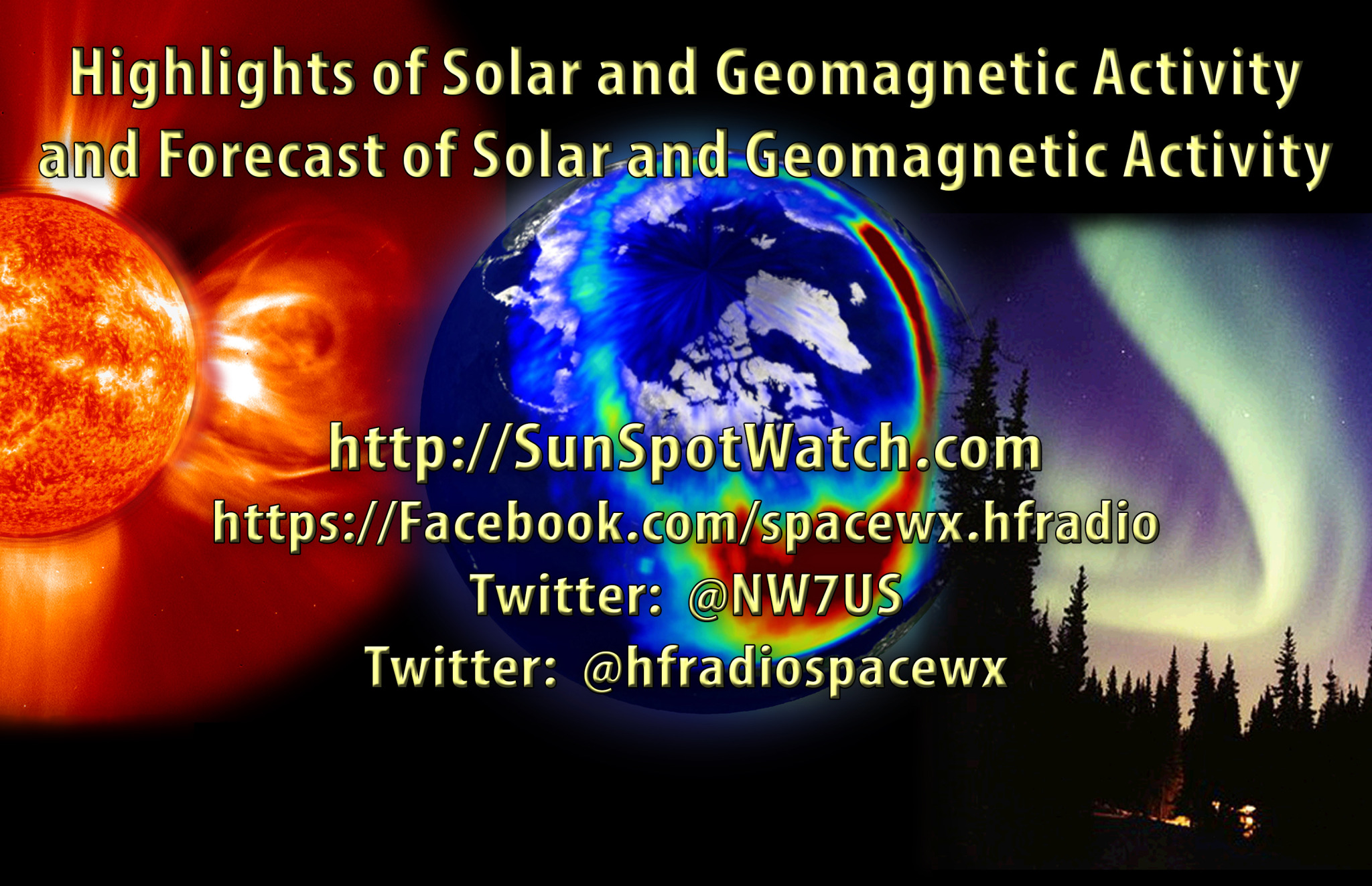 Weekly Propagation Summary – 2020 Aug 03 16:10 UTC
Weekly Propagation Summary – 2020 Aug 03 16:10 UTC
Here is this week’s space weather and geophysical report, issued 2020 Aug 03 0354 UTC.
Highlights of Solar and Geomagnetic Activity 27 July – 02 August 2020
Solar activity was very low throughout the period. Three spotted regions populated the disk at various times during the summary period. Region 2767 (S21, L=200, class/area Hsx/120 on 26 Jul) maintained an H-type configuration through the period and was quiet and stable. Region 2768 (N26, L=111, class/area Hsx/020 on 30 Jul) formed on the disk on 28 Jul and decayed to plage by 02 Aug. It was quiet and stable. Region 2769 (N26, L=059, class/area Axx/010 on 02 Aug) quietly rotated onto the disk.
An eruptive prominence was observed off the SE limb about midday on 31 Jul. A slow-moving CME was subsequently observed, but was determined to not have an Earth-directed component. No other CMEs or activity of note was observed during the summary period.
No proton events were observed at geosynchronous orbit.
The greater than 2 MeV electron flux at geosynchronous orbit was at normal to moderate levels through the period.
Geomagnetic field activity was at quiet levels through midday on 02 Aug when unsettled activity was observed due to positive polarity CH HSS influence. Solar wind observations indicated nominal conditions through about 02/0600 UTC when a CIR, in advance of a positive polalarity CH HSS, became evident in the data. Wind speeds increased from about 310 km/s to near 530 km/s, total field increased to 12 nT and the Bz component reached -10 nT. The geomagnetic field reacted with mostly unsettled conditions.
Forecast of Solar and Geomagnetic Activity 03 August – 29 August 2020
Solar activity is expected to be at very low levels throughout the outlook period.
No proton events are expected at geosynchronous orbit.
The greater than 2 MeV electron flux at geosynchronous orbit is expected to be at normal to moderate levels throughout the outlook period.
Geomagnetic field activity is expected to be at unsettled to active levels through 03 Aug with a chance for G1 (Minor) geomagnetic storm levels due to recurrent CH HSS effects. Quiet to unsettled levels are expected on 04 Aug as HSS effects persist. Unsettled levels are expected once again on 29 Aug. Quiet levels are expected to prevail for the remainder of the period, 05-28 Aug.
Don’t forget to visit our live space weather and radio propagation web site, at: http://SunSpotWatch.com/
Live Aurora mapping is at http://aurora.sunspotwatch.com/
If you are on Twitter, please follow these two users: 1. https://Twitter.com/NW7US 2. https://Twitter.com/hfradiospacewx
– – – – – – – – – – – – –
Be sure to subscribe to our space weather and propagation email group, on Groups.io
https://groups.io/g/propagation-and-space-weather
Spread the word!
– – – – – – – – – – – – –
Links of interest:
+ Amazon space weather books: http://g.nw7us.us/fbssw-aSWSC
+ https://Twitter.com/NW7US
+ https://Twitter.com/hfradiospacewx
Space Weather and Ham Radio YouTube Channel News:
I am working on launching a YouTube channel overhaul, that includes series of videos about space weather, radio signal propagation, and more.
Additionally, I am working on improving the educational efforts via the email, Facebook, YouTube, Tumblr, and other activities.
You can help!
Please consider becoming a Patron of these space weather and radio communications services, beginning with the YouTube channel:
https://www.patreon.com/NW7US
The YouTube channel:
https://YouTube.com/NW7US
..
Visit, subscribe: NW7US Radio Communications and Propagation YouTube Channel
 ICQ Podcast Episode 330 – Organising a SOTA Weekend
ICQ Podcast Episode 330 – Organising a SOTA Weekend
In this episode, Martin M1MRB is joined by Chris Howard M0TCH, Martin Rothwell M0SGL, Ed Durrant DD5LP, Frank Howell K4FMH and Bill Barnes WC3B to discuss the latest Amateur / Ham Radio news. Colin M6BOY rounds up the news in brief and this episode’s feature is Organising a SOTA Weekend.
ICQ AMATEUR/HAM RADIO PODCAST DONORS
We would like to thank an anonymous donor along with our monthly and annual subscription donors for keeping the podcast advert free. To donate, please visit - http://www.icqpodcast.com/donate
- Australian Call Sign Structure - ARRL - What's wrong with ham radio? - Unauthorized Transmissions in 144 MHz Satellite Allocation - HobbyKing Fined Nearly $3 Million for Marketing Unauthorized Drone Transmitters - High school Marine Buoy Transmitter Now Active on 20m WSPR - QSO Today Virtual Ham Expo - SOTA Day 2020 (Austrian) - RASA’s QTC Magazine Moves to Fully Electronic
Colin Butler, M6BOY, is the host of the ICQ Podcast, a weekly radio show about Amateur Radio. Contact him at [email protected].
 Ham College 67
Ham College 67
Ham College episode 67 is now available for download.
Extra Class Exam Questions – Part 5
E1E Volunteer examiner program: definitions, qualifications, preparation and administration of exams, accreditation, question pools, documentation requirements.
57:40
George Thomas, W5JDX, is co-host of AmateurLogic.TV, an original amateur radio video program hosted by George Thomas (W5JDX), Tommy Martin (N5ZNO), Peter Berrett (VK3PB), and Emile Diodene (KE5QKR). Contact him at [email protected].
 Tweaking the Endfed antenna SWR chart correction
Tweaking the Endfed antenna SWR chart correction
Mike Weir, VE9KK, is a regular contributor to AmateurRadio.com and writes from New Brunswick, Canada. Contact him at [email protected].
 New Hope For Cycle 25!
New Hope For Cycle 25!

Unlike most forecasts for solar Cycle 25, a recently released paper from five solar scientists (1) has given many 6m diehards new reasons to hope!
After countless dire predictions for the upcoming cycle indicating similar or even poorer activity levels than the disappointing Cycle 24, the new paper suggests just the opposite!
In fact, the group of scientists predict that "Cycle 25 will probably be among the strongest solar cycles ever observed, and that it will almost certainly be stronger than present SC24 (116 spots) and most likely stronger than the previous cycle 23 (180 spots)." The possibility of a smoothed sunspot number (SSN) reaching as high as 305 is in the prediction!
Solar Cycle 19 was a monster, reaching a SSN level of 285 ... to imagine the possibility of something even stronger is truly exciting. The just-ending Cycle 24 was one of the weakest on record, reaching an SSN of just 116.
 |
| Will Cycle 25 replace Cycle 19 as #1? Image source with my addition in RED. |
During Cycle 24, maximum usable frequencies (MUF) for F2 propagation often struggled just to reach 28MHz, and except for the peak year, the worldwide propagation conditions that amateurs had come to expect were often absent.
Should these new optimistic predictions come to pass, 6m operators can look forward to some truly, never-before-seen, fall and winter propagation ... for at least three or more winters.
With SSN values reaching the high two-hundreds or beyond, west coast operators can expect to see the 6m band often open before sunrise, most likely favoring Europe via the polar path or towards Africa via the trans-Atlantic path. Unlike 20m, there will be little to no ‘polar flutter’ and since signals propagating near the F2 MUF suffer very little path loss, they will probably be very strong.
Later in the day, propagation will shift south towards Central and South America before moving to the west. Depending on the time of year, the propagation will favor Asia, with signals from Japan, China and other far-eastern exotica in the early fall through the New Year. As well, the band will often stay open for some time after local sunset. Late winter and spring will see the western path favour signals from down under, and stretch out to the southern far east regions towards the Indian Ocean. These were the propagation patterns noted from here during Cycles 21-23, when SSNs reached 233, 214 and 180 respectively.
With much gratitude to Mark (VA7MM) for converting my old analog tapes to mp3, here is a recording I made on the morning of November 7, 1979, at the height of Cycle 21. It will give you a taste of what could be in store. On that Wednesday morning, the band opened around 0800 and continued through to sunset, closing with a three-hour opening to the Pacific and Japan. Like many other 6m operators, I had taken the day off work with a case of the 'F2 flu' that was very prevalent that winter! The recording begins with a short exchange between VE1ASJ and VE1AVX, while trying to work their first KL7 ...
The graph of Cycle 21 shows when the recording was made. Although not known at the time, it was very close to the peak of the cycle.
 |
| courtesy: http://www.solen.info/solar/ |
 |
| courtesy: http://www.solen.info/solar/ |
A record-busting Cycle 25 will be like these previous cycles only on steroids! With such a cycle, 10m will follow a similar pattern but will likely be open 24/7 as I recall listening to VKs and ZLs on 10m AM well after midnight during the downward climb of Cycle 19 ... and this was on a very '10m-deaf' Hallicrafters S-38 and a short wire out the attic window!
For those wanting to read the fascinating paper (Overlapping Magnetic Activity Cycles and the Sunspot Number: Forecasting Sunspot Cycle 25 Amplitude), you can find a pdf here. As well, you can read the ARRL’s own announcement of this exciting possibility here.
One certainty is, that if FT8 is still around by then, it and your soundcard will fold up quickly once the band opens with wall-to-wall S9++ signals. It may be useful during the first early minutes or during marginal openings, but knowing the signal levels that 6m F2 can produce, it will be like trying to use FT8 with dozens of new neighbors operating on your own block ... and you can easily guess how well that might work! As we’ve come to understand, FT8 is a wonderful weak-signal mode, but throw just one bone-crushing signal into the waterfall and it’s game-over ... on F2, there will be dozens of these!
Such stellar conditions on 6m are ideally suited to CW or SSB and I think there will be a fast exodus from FT8 back to the traditional modes very early ... those that aren’t prepared for this, relying only on FT8, will most likely be in for a rude awakening. If you’re a 6m “no-coder”, now’s the time to hunker-down and learn CW ... by the time Cycle 25 becomes productive, you won’t be left out of the many CW DX opportunities that will surely be available on this much quicker QSO mode.
We will no doubt be reading more about this as Cycle 25 begins to grow. As in almost all stronger than normal cycles, growth from the start to the peak is much shorter than normal so I’ll be watching for a fast rise in sunspot numbers once we are really underway.
Hindcast modelling (backtesting) of the data derived from previous cycles going back to the 1700s using the paper’s prediction methodology, shows an accurate alignment with what actually occurred. The red dots in the graph above indicate the model’s predicted peak superimposed on the actual peak. In some cases, the peaks were even higher than the modelling suggested.
The predictions identify the so-called “termination” events, landmarks marking the start and end of sunspot and magnetic activity cycles, extracting a relationship between the temporal spacing of terminators and the magnitude of sunspot cycles. The success of these predictions will depend upon an upcoming terminator event before the end of 2020. Should it occur on time, the predictions will be given a much greater chance of coming to fruition ... "with a terminator event in 2020, we deduce that sunspot cycle 25 will have a magnitude that rivals the top few since records began. This outcome would be in stark contrast to the community consensus estimate of sunspot cycle 25 magnitude."
More interesting discussions of the paper can be found here and here.
This week's high-latitude Cycle 25 sunspots are a great sign. When the terminator event occurs, solar activity will ramp-up very quickly, within one 27 day solar rotation. Let's hope we're getting close.
As noted in the paper, "Very early indications of the spot pattern are appearing at higher than average latitudes. Historically, high latitude spot emergence has been associated with the development of large amplitude sunspot cycles — only time will tell."
Hopefully we’ll all need to hold on to our hats ... it just might just be the ride of our lives!
(1) Scott W. McIntosh (1), Sandra C. Chapman (2), Robert J. Leamon (3,4), Ricky Egeland (1), and Nicholas W. Watkins (2,5,6)
1 National Center for Atmospheric Research, P.O. Box 3000, Boulder, CO 80307, USA.
2 Centre for Fusion, Space and Astrophysics, University of Warwick, Coventry CV4 7AL, UK
3 University of Maryland, Department of Astronomy, College Park, MD 20742, USA.
4 NASA Goddard Space Flight Center, Code 672, Greenbelt, MD 20771, USA.
5 Centre for the Analysis of Time Series, London School of Economics and Political Science, London WC2A 2AZ, UK
6 School of Engineering and Innovation, STEM Faculty, The Open University, Milton Keynes, UK
Steve McDonald, VE7SL, is a regular contributor to AmateurRadio.com and writes from British Columbia, Canada. Contact him at [email protected].
 Tweaking the Endfed antenna.
Tweaking the Endfed antenna.
 |
| Three feet of wire |
With the counterpoise attached, I went into the shack and ran through the bands using my MFJ 259B antenna analyzer and recorded the results and then once again with the counterpose removed. As a side note, one of the best purchases I made was the antenna analyzer, it makes short work of most antenna testing tasks. I do have a second antenna analyzer which is the Funk FA-VA4 its a nice unit but because its menu-driven I find it to be a bit cumbersome. With the MFJ unit, you select the band range with one knob and with the other knob spin to your desired frequency and then read the LED readout.
Well back to the Endfed experiment and below are the results with the added 3 feet of wire.
Results without a counterpoise:
Band Freq SWR
- 80. 4.000. 7.5
- 80. 3.500. 6.7
- 40. 7.001. 3.2
40. 7.070. 3.3
30. 10.100. 5.0
30. 10.150. 5.0
20. 14.001. 1.8
20. 14.070. 1.7
17. 18.068. 1.6
17. 18.168. 1.6
21. 21.001. 2.6
21. 21.070. 2.6
Results with a counterpoise:
Band Freq SWR
- 80. 4.000. 9.1
- 80. 3.500. 9.6
- 40. 7.001. 4.4
40. 7.070. 4.4
30. 10.100. 5.0
30. 10.150. 5.0
20. 14.001. 2.4
20. 14.070. 2.3
17. 18.068. 2.0
17. 18.168. 2.0
21. 21.001. 2.6
21. 21.070. 2.7
 |
| bungee allowing for flex when 41 feet long. |
Mike Weir, VE9KK, is a regular contributor to AmateurRadio.com and writes from New Brunswick, Canada. Contact him at [email protected].
 LHS Episode #359: Backup Solutions Deep Dive
LHS Episode #359: Backup Solutions Deep Dive

Welcome to Episode 359 of Linux in the Ham Shack. In this episode, the hosts take a deep dive into the world of real-time backups, archiving, replication, data storage, cloud services and more. Everyone should have a reasonable backup and disaster recovery solution and this episode hopes to provide several options for accomplishing that goal with open source software and hardware in mind. Thanks for listening and we hope you have a great week and good backups.
73 de The LHS Crew
Russ Woodman, K5TUX, co-hosts the Linux in the Ham Shack podcast which is available for download in both MP3 and OGG audio format. Contact him at [email protected].















